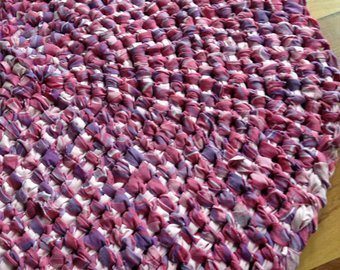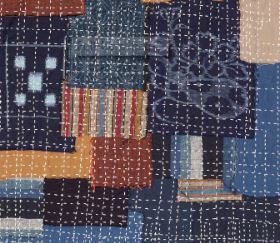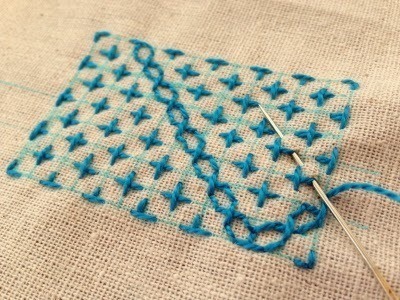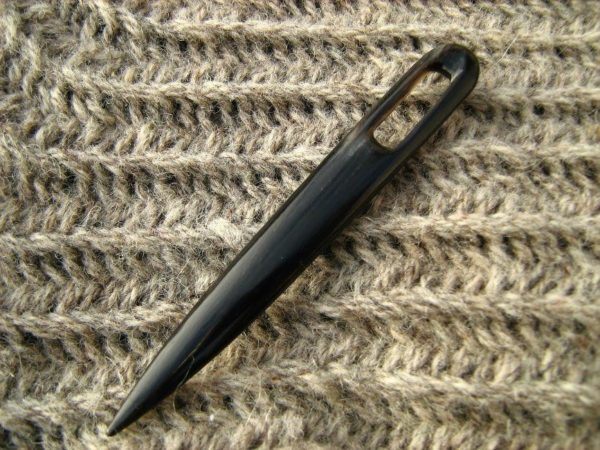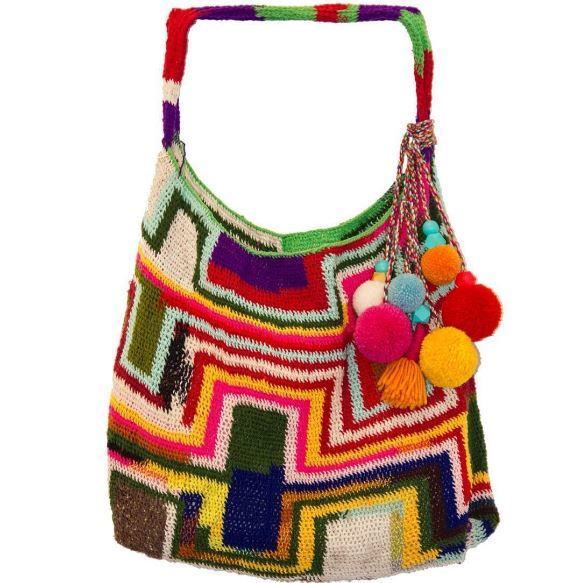How to Make an Amish Toothbrush Rag Rug

Amish Knot Rug by Lisa Pidgeon screen grab
A really great recycling project is to make a toothbrush rag rug. You don’t actually need a toothbrush…it’s just a left-over term from half a century ago.
You can make a rug that’s the size and the colors you want from old sheets and cotton that no longer serve their original purposes.
It requires ripping, making small cuts, and doing lots of threading loops and pulling them tight. That’s it—no sewing! Below are some written and video instructions to get you started.
Gather Some Material
You’re going to rip cotton into long strips that are 1 ½ to 2 inches wide, and about 44 inches long. Once you’ve got the hang of it, you can make the pieces as long or short as you want, depending on how much ‘tail’ you can tolerate when doing the threading, and how often you’d like the colors and patterns to change.
You’ll need old sheets or fabric that’s easy to rip. You can aim to have a plain color rug, whether it’s a solid color or several solid colors. Or you can use fabric with patterns – which, when worked into knots that make up your rug, will end up in a mottled pattern.
To make this rug, you’ll be connecting long pieces of scrap fabric together. For your first rug, you should try and gather lightweight cotton that’s flexible and easy to handle.
When you get used to this technique, you’ll be able to mix up fabrics with different weights as much as you like and handle changes in flexibility like a pro.
Join the strips
You’ve got scrap fabric that’s been cut or ripped into pieces that are 1 ½ to 2” wide x 44” long. At each of the two ends of the long strips, you’ll need to cut a small slit. This slit is how you’re going to join one piece of fabric to the next. Using sharp scissors, cut about a ½ inch slit in the end, starting at about ½ inch in from the end. The easiest way to do this is to fold over the end and make a ¼ inch snip on the fold.
Let’s call the 1st strip Strip A, the second Strip B, and so on. To start your rug, you’re going to have to join an anchor strip to another one. To start this process, feed Strip B through an end snipped hole of Strip A. Feed it through just 6 inches or so. Then take the other end of Strip B and put it through the snipped end of Strip B that just got passed through Strip A. Pull it all the way through, and tighten it a bit.
This way of joining two strips - an Amish knot - gives you something that looks like a mini necktie knot.
Sometimes it’s just easier to watch an example…Barri-Jayne Makes has a wonderful video tutorial 'How to Make a Round Amish Knot Toothbrush Rag Rug.'
Watch below:
Make the Loops
Barri-Jayne explains that years ago every toothbrush had a hole in the handle. Toothbrushes would be upcycled to become rug-making needles, by cutting off the brush end and rounding it off. So, the fabric would be threaded through the toothbrush hole.
These days you can purchase a rag rug needle, or you can create your own needle from some wire and masking tape, as Barri-Jayne shows us at 1:20 in her video.
Barri-Jayne creates the rug from a center and works her way outward, making circles of knots. You can stop whenever you feel your rug is the size you want.
After you’ve made a few circles by looping fabric through holes, you’ll see that your holes are becoming much bigger than your original holes. You’ll create more holes in the next circle by doubling the number of loops you make in each hole, in order to keep the rug the same mass throughout. You can see this technique at 10:35 in the video. Then, you’ll go back to one loop per hole.
When your strip of fabric becomes short because most of it has been worked into your rug, you’ll add another strip by the snip-and-feed no-sew method of joining two strips together.
Just keep going round and round until you’ve got the size rug you want. To finish the rug off, you’ll tie the two strips together in a square knot, and tuck the ends through several loops on the underside of the rug, just to keep them out of the way and not visible.
Below are two more videos from Barri-Jayne Makes: How to Make an Oval Amish Toothbrush Rag Rug, and Washing Handmade Amish Rag Rugs.
If you're an upcycling or farmhouse-style enthusiast, you might also like The Lost Art of Braid-in Rag Rugs and How to Make a Rag Rug. If you like to repurpose fabric and yarn, you might like our post DIY MIndset.
Amish-Made Goods
Want to explore some hand-made dollhouses, doll clothes, doll quilts, and dollhouse furniture made by Ohio-based Amish craftspersons? To see and purchase, visit our post Amish Made Dollhouses. The sturdy wooden miniatures and cotton doll clothes and quilts are a great addition to any doll collection, and are made to last.
Books
Below are shopping links to some books that would be a great addition to any DIY- and farmhouse-style household. Please note that as an Amazon Associate I earn from qualifying purchases - at no extra cost to you!
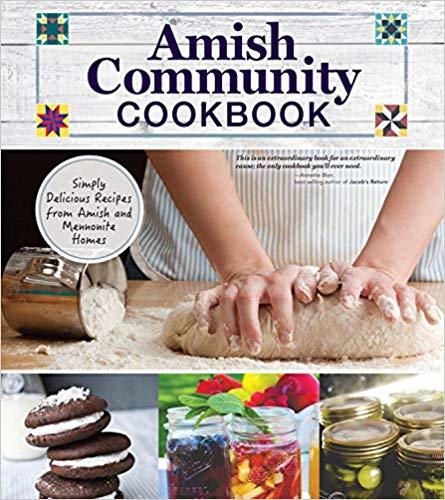
This cook book features Amish and Mennonite comfort food recipes, including homemade root beer, Shoofly Pie, Apple Dumplings, Chicken Pot Pie, Rhubarb Jam, and more.
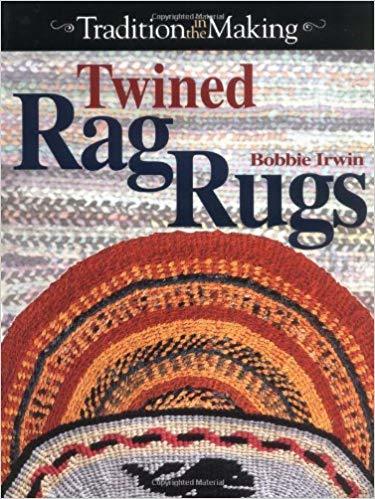
This book will teach you how to create a twined rag rug, using a homemade frame and scrap fabric. It includes step-by-step diagrams and photos for 9 samplers.
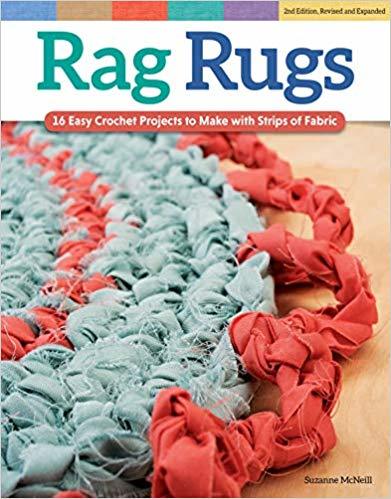
With gorgeous color photographs and clear, straightforward instructions, Suzanne McNeill presents 16 projects to make with strips of fabric. For rafters of all ages and skill levels.
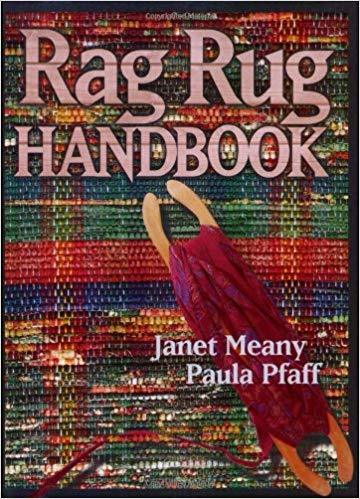
This classic book has everything a weaver needs to know about weaving rag rugs, from basic information to drafts for 20 traditional two- and four-shaft patterns.
Having fun with new and traditional crafts, art, design, DIY, and freebies.
TRENDING & POPULAR
FREE ART BOOKS ONLINE Start your own free collection of art books from three major museums.
HOW TO MAKE AN AMISH RAG RUG There's no sewing required to make this traditional homemade crafted item.
HOW TO MAKE A BORO BAG Learn how to make a stand-out bag using a Japanese patchwork technique and Sashiko stitching.
DISCOVER SASHIKO STITCHING Learn how to make traditional Japanese decorative stitches for quilting, mending, and upcycling.
35,000 FREE KNITTING & CROCHETING PATTERNS Use our easily searchable list to find free patterns by Rowan, Vogue, Lion Brand, Berroco, and more.
'KNIT' LIKE THE VIKINGS Discover an ancient fabric-making technique that's still done today, pre-dates knitting, and doesn't unravel.
BILUM Discover a fabric-making technique used in Papua New Guinea that can be used to make bags and dresses.










